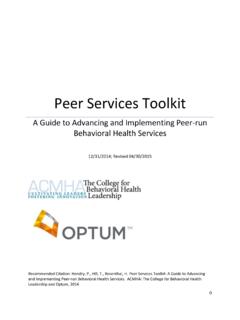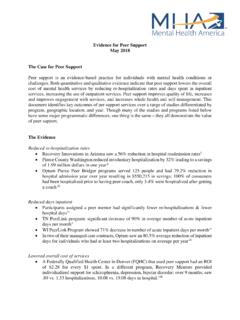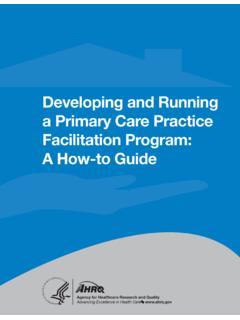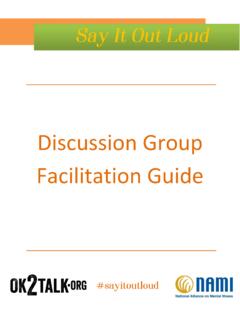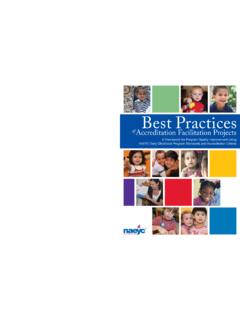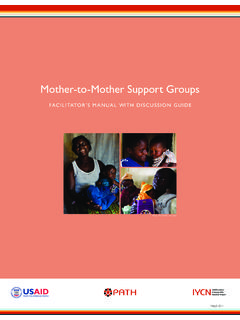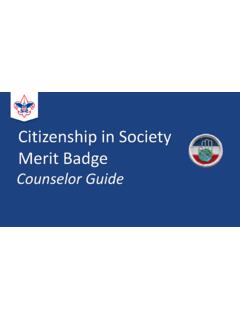Transcription of Support Group Facilitation Guide - Mental Health America
1 Mental Health America 's Support Group Facilitation Guide 1. 2016. Table of Contents Support Group Basics _____3. Facilitator Functions _____6. Facilitator Skills _____10. Self-Care _____10. Effective Listening _____16. Communication _____18. Problem Solving _____19. Conflict Resolution _____21. Boundaries _____22. Managing Disruptive Members _____24. Handling Crisis Situations _____26. Self-Reflection _____28. Co- Facilitation _____29. Preparing for Meetings _____33. Starting and Ending Meetings _____35. Support Group Guidelines _____38. Suggestions for Facilitators _____41. Available Resources _____43. 2. Support Group Basics A Support Group can be defined as a gathering of people with common experiences and concerns who meet together to provide emotional and moral Support for one another.
2 They encourage a sense of community, a source of empathetic understanding and provide an avenue for establishing social networks. Meetings can take place in person, over the phone or online. Some groups are ongoing, while others have a predetermined start and end or total number of sessions for the Group . Meetings are directed by the Support Group Facilitator. They have the charge to Guide Group members in a healthy and purposeful discussion that will help them address the issues for which the Group is designed. Support groups can be facilitated in a variety of formats, including having different types of facilitators. Groups that are structured as Self-Help are often organized and managed by members only. There are no professionals who facilitate the Group aside from the members, known as Peers.
3 Peer Facilitators are those who have actually lived the experience being addressed by the Group . They are open about their experiences and use them to connect with Group members on a personal level. While they are generally not considered accredited professionals, many Peer Facilitators hold the credential of Certified Peer Specialist. The CPS receives in-depth training on the concepts of recovery, peer Support , and how to utilize their own journey of recovery to assist others. Mental Health America offers the National Certified Peer Specialist credential with the highest standards of knowledge, training and experience in the country. 3. The benefit of Peer Support Groups is the comfort and comradery resulting from knowing that everyone there has some experience with the issue at hand.
4 It creates a non-judgmental atmosphere for people to be able to express their feelings and share their experiences with others who can relate. Traditionally, self-help groups are not the same as Group therapy . In peer Support and self-help groups all members maintain mutuality. If a member (including the facilitator) does hold a formal license or credential, they still participate in the Group as a peer rather than as a clinician. Groups structured as Professionally-Facilitated are usually organized and facilitated by professionals who do not share the members' first-hand experience with the Group issue. These professionals can be Mental Health practitioners, psychologists, social workers, religious officials, etc. Others are conducted by individuals who do not have personal experience with the Group issue, nor are they credentialed as a service provider.
5 They are specially trained as Expert Facilitators. Within these categories, there are generally three format models for Support groups. 1) Curriculum-Based: These are frequently psycho-educational groups, a model which incorporates both illness-specific information and tools for managing related circumstances. They stress Health , collaboration, coping, and empowerment through information. In curriculum-based groups, there are several planned topics to discuss over time. Topics are arranged in a pre-determined order of presentation. Books, 4. articles, or other literature related to the topics are distributed and used to Guide Group discussions focused on each topic in relation to the Group members' recovery. 2) Topic Focused: Discussions are focused on recovery in relation to one topic area, but are often less structured than the curriculum-based format.
6 Topics can be rotated based upon the interests of the Group members. Questions related to the topic are posed to the Group . Written materials may be provided to aid in discussion. Members are asked to share their opinions or personal experiences with recovery as related to the written material. 3) Open Forum: The structure of the other two models does not apply. Seldom is there a pre-arranged agenda for the meeting. Because these groups are usually open for participants to drop-in , there may not be rules regarding regular attendance. Discussions uniquely unfurl based upon the interests and needs of the Group members for that particular meeting. Support groups are a powerful resource for individuals dealing with illnesses or other challenging situations. The format model and facilitator type should be selected based on the needs, focus and purpose of the Support Group .
7 5. Facilitator Functions Group facilitators work to promote the processes that help the Group meet its goals while ensuring that the structures, norms, and culture in the Group environment are favorable to the accomplishment of the established goals. This includes taking appropriate action in response to the status of the Group and its members. Facilitators also stimulate discussions designed to Support and encourage progress for the Group as a whole and for each member as an individual. Their main function is to foster communication among the Group and to model effective interaction that members can emulate. Facilitators also provide an example of how to share in the Group . They: Maintain a Safe Environment This involves both physical and emotional safety. The facility that hosts the meeting needs to meet basic needs for the Group .
8 As appropriate and available, this includes easy access (including accommodations for members with physical limitations), comfort (such as climate control, proper ventilation, etc.) and accessible restrooms. Members should also be made aware of the locations of Emergency Exits and other instructions in the event of an environmental emergency. Keeping the environment emotionally safe is equally important. Facilitators will ensure confidentiality is being respected, Group boundaries (structure, schedule, roles, etc.) remain intact, and that members are protected whenever possible from situations that are highly triggering, threatening or otherwise unsafe. If these 6. situations occur, facilitators need to ensure the necessary actions are taken to restore safety and Support any individuals affected.
9 Ensure a Supportive Environment Diversity can be a great asset for a Support Group . It allows for a variety of perspectives and ideas to be presented. Diversity can also pose a challenge to Group cohesion, particularly if there is a sole individual in the meeting that does not identify with the dominant demographic. Demographic composition elements such as age, social class, education levels and languages can impact a member's ability to relate to other members. With a mixed composition, facilitators need to plan ways to aid members to manage concerns about their differences if they arise during meetings. The facilitator should use their mediation and communication skills to promote ways of understanding and accepting differences. It is part of the facilitator's role to foster an environment that is inclusive of all members by highlighting commonalities more than differences.
10 Bolster Affect Exploration Support Group Facilitation necessitates discernment of the inward disposition of Group members and aiding members in exploring, interpreting and reflecting on individual and Group affect. Scanning the room, looking at individual members during Group interaction, allows the facilitator to be aware of verbal as well as nonverbal cues. Verbalizing some scans can be a useful tool to inform the Group of commonalities the facilitator has recognized. 7. ( Jack, I noticed you were nodding your head to Jill's comment. Can you relate to what she shared? ). When facilitators perceive a tense atmosphere in response to a particular subject, it is important to assess the advantages and disadvantages of continuing with the subject. ( I can tell this is difficult, but if it's okay, I think we should try to explore this a bit further.)
